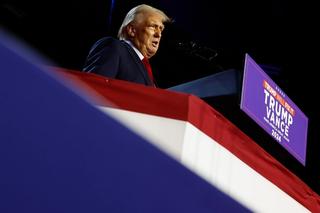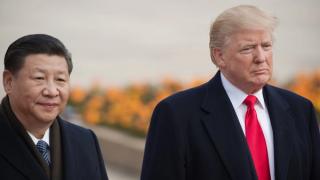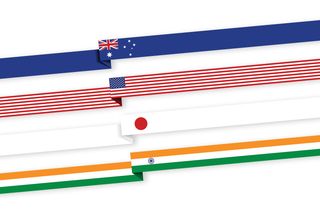Here are four guideposts for managing Trump 2.0, informed by my time as Scott Morrison’s chief of staff.
Unpredictability is a feature, not a bug, of a Trump presidency. That’s not news, but it underlines why dealing with the reality of a Trump White House, as distinct from rhetoric and promises, now requires diplomatic discipline and agility from Australia. Hunkering down is not an option. Nor is indulgence driven by domestic politics.
Let’s start with the positives. Australia is a top-tier US ally and came through Trump 1.0 with an enhanced reputation in Washington. We have lent in on the next phase of the security alliance through the AUKUS agreement, which includes a $3 billion Australian investment in the US defence industrial base.
Moreover, Trump’s obsession with bilateral trade deficits and unfair trade practices finds no outlet with Australia. The US bilateral trade surplus with Australia was more than $30 billion in 2023 and our free trade agreement guarantees US exporters open market access. We also have a $2 trillion bilateral investment relationship that provides mutual benefits.
None of this guarantees Australia will not be in for a wild ride. On trade policy alone, the threat of across-the-board tariffs could disrupt an already fragile geopolitical and economic landscape.
The global economic order is entering uncharted waters. Having torn up the free trade Washington Consensus years ago, President-elect Trump now has a second opportunity to leave a lasting policy legacy over the next four years.
For Australian officials, all eyes are on trade policy in Trump 2.0. The list of Trump tariff proposals floated during the campaign is eye-watering: 60 per cent tariffs on China, 10-20 per cent tariffs on everyone else, tariffs unless countries use the US dollar, tariffs on Mexico unless it halts border crossings, tariffs to cut income tax, and more.
Most economists see such proposals as anti-growth, inflationary and regressive in their disproportionate impact on low-income Americans. That’s all true, but in the near term markets appear buoyed by Trump’s traditional Republican agenda of cutting taxes and regulation.
Transactional Trump. Or True-Believer Trump. That is the question.
So, what is to be done? Here are four guideposts for managing Trump 2.0, informed by my time as Scott Morrison’s chief of staff.
Be clear about Australia’s offering and be ready to deal. Australia was successful in side-stepping the tariff wave of Trump 1.0 and we need to be on our game again. All the outreach by Kevin Rudd and his team in the Washington embassy will now come into play. But as the saying goes: “You can’t fight something with nothing.”
If mega tariffs threaten to tank the stock market, we need Wall Street Trump to keep Blue-Collar Trump at bay.
Australia needs a strong and tangible plan to bolster our influence, one that mobilises the US national security community on our behalf. The focus should be on defence investments here and in the US, technology co-operation and “economic security” measures to bolster vital supply chains.
Critical minerals provide the obvious area of focus. The Trump administration will inherit from President Joe Biden significant work aimed at breaking China’s stranglehold on processed critical minerals vital to national security. Australia has an important role to play in driving this work forward with concrete actions.
Work closely with Japan and congressional allies. Too often, we downplay Japan’s regional clout and its centrality to America’s Indo-Pacific strategy. With our security and economic interests so closely aligned, this is the moment for the Australia-Japan relationship to demonstrate its capabilities and agency. That means working in lockstep to influence US positions on trade, China policy and relations with South-East Asia. To borrow Hillary Clinton’s failed 2016 campaign slogan, we’re stronger together.

Even seasoned political observers in Australia are prone to overlook the role Congress plays as the legislative branch of government. It will necessarily play a vital role to in either enabling or checking President Trump’s actions.
On AUKUS, regional alliances, trade and energy policy, Congress has critical powers that cannot be taken for granted. To take one example, while candidate Trump has promised to revoke China’s Permanent Normal Trade Relations status, any move requires congressional legislation. Mobilising the diffuse centres of power in Washington in Australia’s interests will be more important than ever.
Pray for a Wall Street Treasury Secretary. OK, prayer is hardly a plan. But the main point surrounds the inevitable tensions in a Trump White House between MAGA loyalists and traditional Wall Street Republicans. That was the case in Trump 1.0 and will likely be the case again.
Donald Trump likes to be popular and sees the economy and the stock market as central to his brand. Though understated, former treasury secretary Steve Mnuchin was extraordinarily successful in walking Trump back from unplugged economic nationalism in his first stint as president. Yet the split in Republican ranks is not just based on who Trump talks to last. It runs through Trump himself in the form of Blue-Collar Trump versus Wall Street Trump.
Australia’s Wall Street connections should be drafted into service. If mega tariffs threaten to tank the stock market, we need Wall Street Trump to keep Blue-Collar Trump at bay.
Get our own house in order. National strength in all its dimensions begins at home with a strong economy. The US economy has dramatically outperformed other advanced economies since COVID, including Australia. Technocrats sniff at Trump’s populism, but often overlook the fundamentals of US economic success. Many factors underpin it, but one variable looms large – the permissive regulatory environment that allows capital and labour to move from declining sectors and firms to rising ones.
Currently, Australia seems determined to head in the other direction with greater industry and workplace regulation. If we’re serious about navigating the next few years in a more complex geopolitical and economic setting, we need to change course.









